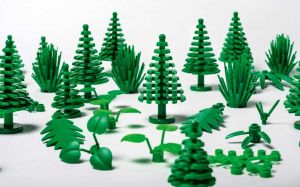A large container of hand-me-down, 40 year old Lego bricks recently arrived from the in-laws. My son’s response: bliss. My husband’s: nostalgia. Mine: equal parts admiration and eco-anxiety.
When asked what he’d like for his birthday, my son’s response is always: Legos. From a sentimental point of view, a timeless toy is a thing of beauty: as creative and engaging today as 40 years ago — no additional bells, whistles or batteries required. From an engineering and manufacturing perspective, they’re equally brilliant: these old Lego blocks are nearly pristine and fit together seamlessly with every other Lego block ever produced. Even with the present-day ethos of built-in obsolescence, Lego blocks offer longevity, continuity and durability. The bottoms of my feet confirm that 40 year old corners are still super sharp.
Part of what makes our Legos magical is that while they would never biodegrade if thrown away, we have never thrown ours out. Ours have been passed from one generation to the next…and are still used regularly today.

At first blush, upon seeing the new Lego “botanical elements” (leaves, trees and bushes), I was excited by the prospect of such a popular petroleum-based plastic product going green(er). The switch from oil-based plastic to plant-based bioplastic is a huge stride in the reduction of their carbon footprint. However, in 2018, this represents a very small percentage of their output — just 1-2% of their products. They’ve stated that this is part of their commitment to use sustainable materials in their core products and packaging by 2030.
As PR pieces propagate media outlets touting the virtues of Lego’s new “sustainable” “eco-friendly” bricks, I cannot quiet the voice repeating that the new pieces are not sustainable as much as they are less unsustainable. This new material, polyethylene, is a bioplastic sourced from sugarcane. It is technically as durable as conventional plastic and far from 100% biodegradable. “Built to last” is great for consumers, but a not for the environment.
In recent years, progressive thinking has shifted from cradle-to-grave to cradle-to-cradle. This change incorporates lightening the carbon footprint of the production and distribution processes not only during a product’s lifecycle but also on the next generation of future products. This approach takes a deeper look at the product itself –its byproducts and components– and how to re-use them after they’ve recached the end of their usable life. This model looks to a product’s “waste” to see how it can be an input for a new product — as fuel, food or energy to be captured and reused.
In 2015, Lego pledged investing $1 billion towards developing a greener alternative material. For a company whose primary product relies heavily on a non-renewable fossil fuel (petroleum), an alternative material is essential. Polyethylene is a step in that direction. Sustainability classes are teaching that while reducing, reusing and recycling are starting points, this new, higher call to action minimizes externalities and used outputs as inputs. This is the elephant in the room: a bioplastic is still a plastic and will be on the planet long after it’s usable life.
Years ago, Greenpeace created Everything is Awesome — a haunting viral video that asked Lego to end it’s relationship with Shell. Increased transparency, visibility and connectivity allowed the message to be broadcast and amplified far and wide. The plastic bricks that people know and love are the main offender…even with carbon imprint reductions in all other areas…their production is tremendously resource intensive.
Lego’s press release touches on many of their green credentials: defining how this fits in with their vision and mission, their company-wide commitment, the defining and monitoring goals, the aligning with corporate policies/guidelines/standards, the inclusion of stakeholders, and the intention to collaborate/partner with NGOs, policymakers and competitors alike. All of these efforts demonstrate their dedication to securing a place in a future sustainable marketplace as leaders and innovators in the sustainable corporate world. Hopefully they will continue on this path and influence others along the way.
